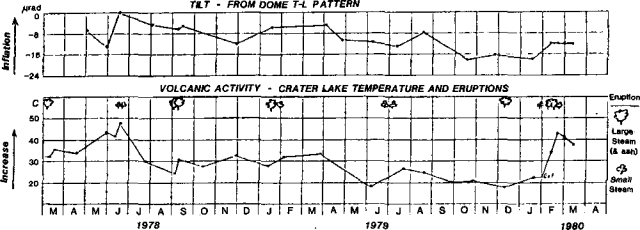Report on Ruapehu (New Zealand) — March 1980
Scientific Event Alert Network Bulletin, vol. 5, no. 3 (March 1980)
Managing Editor: David Squires.
Ruapehu (New Zealand) Small explosions from crater lake
Please cite this report as:
Global Volcanism Program, 1980. Report on Ruapehu (New Zealand) (Squires, D., ed.). Scientific Event Alert Network Bulletin, 5:3. Smithsonian Institution. https://doi.org/10.5479/si.GVP.SEAN198003-241100
Ruapehu
New Zealand
39.28°S, 175.57°E; summit elev. 2797 m
All times are local (unless otherwise noted)
Small phreatic explosions, accompanied by summit inflation and an increase in crater lake temperature, have occurred at Ruapehu, probably beginning in late January (figure 4). During each several-hour summit visit by NZGS personnel (from late January through mid-March), 2-4 explosions took place from the crater lake.
 |
Figure 4. Ruapehu summit tilt in µrad (top) and Crater Lake temperature with eruptions shown schematically (bottom), March 1978-March 1980. |
Although explosion sizes varied, their characteristics were similar. A dark eruption slug of water and particulate matter broke through the lake surface (sometimes preceded by updoming of the lake water), rose a maximum of a few tens of meters, then collapsed to form a toroidal ring. Surtseyan jets formed, distinct from the main mass of ejecta. A steam column was sometimes produced, from which base surges moved radially outward. Waves generated by the explosions usually overtopped the lake outlet, sending pulses of water eastward down the Whangaehu River. Trains of black or yellow sulfur were seen floating on the lake surface after some explosions. Dark floating objects about l m across were also observed, but it was not possible to determine whether these were pumiceous blocks or frothy sulfur.
Lake temperature rose from 22°C on 31 January to 43°C on 22 February, then declined to 37.5° by 14 March. Six µrad of summit inflation took place between surveys on 15 January and 12 February, but no inflation has been measured in the three surveys since then.
The NZGS notes that similar periods of phreatic activity have occurred several times in the past 12 years, including 1968, 1971, 1974, and 1978. The 1971 activity culminated in a major phreatomagmatic eruption, but the eruptions of 1969 and 1975 took place up to a year after such active periods, and the 1977 eruption was not preceded by renewed phreatic events.
Geological Summary. Ruapehu, one of New Zealand's most active volcanoes, is a complex stratovolcano constructed during at least four cone-building episodes dating back to about 200,000 years ago. The dominantly andesitic 110 km3 volcanic massif is elongated in a NNE-SSW direction and surrounded by another 100 km3 ring plain of volcaniclastic debris, including the NW-flank Murimoto debris-avalanche deposit. A series of subplinian eruptions took place between about 22,600 and 10,000 years ago, but pyroclastic flows have been infrequent. The broad summait area and flank contain at least six vents active during the Holocene. Frequent mild-to-moderate explosive eruptions have been recorded from the Te Wai a-Moe (Crater Lake) vent, and tephra characteristics suggest that the crater lake may have formed as recently as 3,000 years ago. Lahars resulting from phreatic eruptions at the summit crater lake are a hazard to a ski area on the upper flanks and lower river valleys.
Information Contacts: B. Houghton, E. Lloyd, and B. McG. Simpson, NZGS, Rotorua; P. Otway, NZGS, Wairakei.

